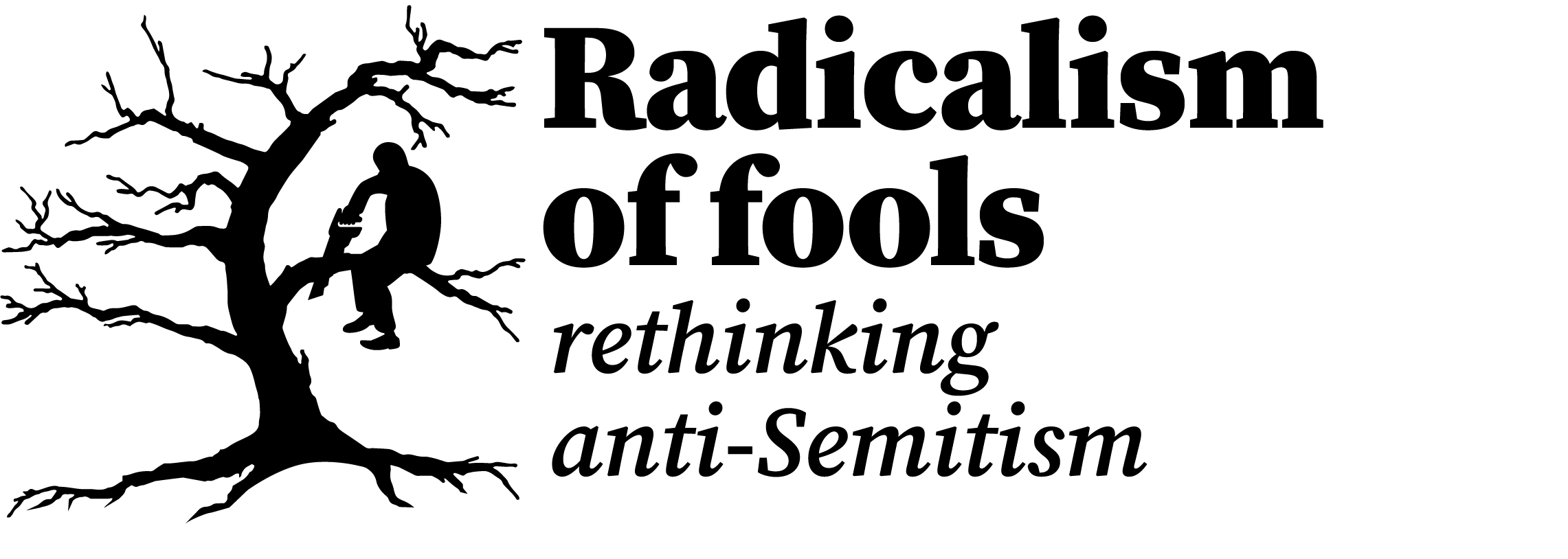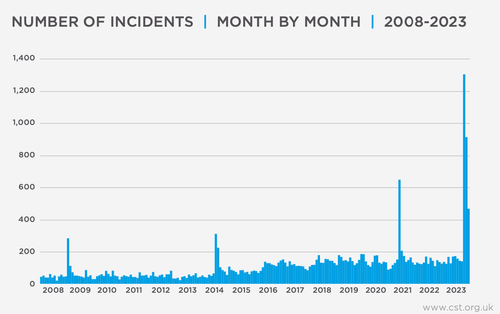Not all statistics are created equal. That applies to those related to anti-Semitism as much as others. To truly understand their significance they need to be carefully interrogated.
In that respect the recent webinar featuring Jonathan Boyd, the executive director of the Institute for Jewish Policy Research (JPR), and organised by the Birkbeck Institute for the Study of Antisemitism (BISA) was instructive (see video below). He is one of the most accomplished authorities on interpreting what such statistics represent.
The most commonly quoted in relation to anti-Semitism in Britain are those based on incidents reported to the Community Security Trust (CST), a charity which provides security to the Jewish community, or to the police. These show clear spikes in July 2014 and May 2021 and October-November 2023 all coinciding with conflicts between Israel and Hamas in Gaza (see bar chart above). The most recent was particularly dramatic. In addition there is a clear upward trend over time.
But how is it possible to know these are accurate? There is a case that they underestimate the true level of anti-Semitism and a contrary case that they overestimate it. Boyd queried both sets of claims.
A key reason they could be an underestimate is that there could be underreporting. That is people who experience some kind of anti-Semitic incident simply do not report it to the CST or to the police. That contention is based on a survey conducted by JPR for the European Union Agency for Fundamental Rights (FRA) in 2018 which suggested that about four out of five incidents are not reported. Another equivalent survey is being conducted at present.
In addition, surveys of the Anglo-Jewish adult population on the JPR Panel showed a much higher proportion saying they had experienced an anti-Semitic incident than is apparent from CST incident reports. For example, 31.6% of Jews told JPR they had experienced an anti-Semitic incident in 2023 compared with only 1.9% in the incident reports.
However, it is likely that the relatively small number of the most serious incidents are more often reported. Physical assault – which thankfully only accounts for a tiny proportion of incidents – is generally reported to the police. Acts of vandalism are more often reported for insurance purposes.
Another reason why the levels of anti-Semitism could be underestimated is that in many cases it is coded. For example, through the use of semiotic markers, such as the word I$rael to represent Israel, or questionable gifs and memes. There are also puns such as Holohoax, IsraeHell, Satanyahu (a reference to the Israeli prime minister) and Zionazis. Then there are allusions (for example, “The Austrian artist was right”), implicit Nazi comparisons (such as “Fourth Reich Rising”) and indirect speech acts ( for instance, “Who owns the British media?”). These kinds of indirect references are the subject of the Decoding Antisemitism project carried out by researchers at the Centre for the Research on Antisemitism (ZfA, Technical University of Berlin) and other academic centres. Overall anti-Semitism often takes such coded forms rather than making explicit references to Jews.
The main case that the reported statistics overstate the level of anti-Semitism is that reasonable criticism of Israel could be mistaken for hatred to Jews. Here Boyd was also clarifying. He made the point that some remarks about Israel are blatantly anti-Semitic while others are clearly not. Boyd did not give examples but it should be clear that someone claiming that Israel is at the centre of an international Jewish conspiracy to control the world is anti-Semitic. On the other hand, someone simply criticising the Israeli prime minister or expressing concerns about the plight of Palestinian civilians in Gaza would not be.
The difficulty comes in the substantial grey area where there is significant uncertainly about whether an action or statement on Israel is anti-Semitic. Here statisticians have to make careful judgements about where to draw the line. This is probably the most controversial area of all.
Again Boyd did not give examples in his short presentation but many of the difficulties are contextual. For example, someone carrying a “Free Palestine” placard on a protest would probably not be considered anti-Semitic. But if someone daubed “Free Palestine” on the side of a synagogue that probably would be.
Boyd also made the point that even if the incidents related to Israel there would still be a significant spike in incidents in 2023. The absolute number of recorded incidents would, by definition, be lower but there nevertheless would still be a sharp increase at that time.
Making international comparisons involves even more challenges. Although the shapes of the graphs of anti-Semitic incidents looks similar – with spikes at similar times – the definitions of what exactly constitute an anti-Semitic incident can differ from country to country. There may also be additional local factors at work. For example, the graph of anti-Semitic incidents in France shows additional spikes, not evident in Britain, which are not related to the conflict with Hamas in Gaza.
Overall all such factors need to be considered to gauge the true extent of anti-Semitism.
*** It should be noted that a rare serious critique of anti-Semitic incident reporting came in article by Joseph Finlay, a musician and academic, in the Spring 2024 edition of Jewish Socialist. He made some reasonable points and others which were more questionable. For example, it is true that assigning particular acts of anti-Semitic abuse that occur online – an inherently international medium - to national statistics is problematic. He also makes the fair and important point that violent abuse is mercifully rare (although Jonathan Boyd also made that point). However, Finlay seems too ready to claim that a large proportion of Israel-related incidents are unfairly classified as anti-Semitic (although it impossible to make a definitive judgement either way without the details). Indeed he does not seem to recognise that anti-Semitism often takes the form of the depiction of Israel as the epitome of evil. He is also too quick to downplay the element of anti-Semitic celebration in Britain of the Hamas pogrom during and shortly after 7 October. Finally, there is no consideration of Boyd’s point that there are good grounds to believe the total number of anti-Semitic incidents is likely to be substantially underreported. As Boyd points out, there are reasons to suggest the statistics underestimate reality as well as reasons to suggest they overestimate it.
The aftermath of the 7 October Hamas pogrom in Israel has made the rethinking of anti-Semitism a more urgent task than ever. Both the extent and character of anti-Semitism is changing. Tragically the open expression of anti-Semitic views is once again becoming respectable. It has also become clearer than ever that anti-Semitism is no longer largely confined to the far right. Woke anti-Semitism and Islamism have also become significant forces.
Under these circumstances I am keen not only to maintain this site but to extend its impact. That means raising funds.
The Radicalism of fools has three subscription levels: Free, Premium and Patron.
Free subscribers will receive all the articles on the site and links to pieces I have written for other publications. Anyone can sign up for free.
Premium subscribers will receive all the benefits available to free subscribers plus my Quarterly Report on Anti-Semitism (from April 2024). They will also receive a signed copy of my Letter on Liberty on Rethinking Anti-Semitism and access to an invitee-only Radicalism
of fools Facebook group. These are available for a 17% discounted annual subscription of £100 or a monthly fee of £10 (or the equivalents in other currencies).
Patron subscribers will receive the benefits of Premium subscribers plus a one-to-one meeting with Daniel. This can either be face-to-face if in London or online. This is available for a 17% discounted annual subscription of £250 or a monthly fee of £25 (or the equivalents in other currencies).
You can sign up to either of the paid levels with any credit or debit card. Just click on the “subscribe now” button below to see the available options for subscribing.
You can of course unsubscribe at any time from any of these subscriptions by clicking “unsubscribe” at the foot of each email.
If you have any comments or questions please contact me at daniel@radicalismoffools.com.

